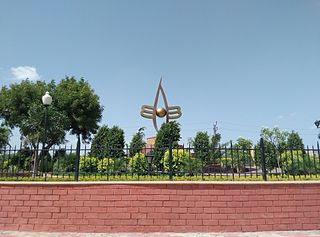
Nathdwara is a city in the Rajsamand district of the state of Rajasthan, India. It is located in the Aravalli hills, on the banks of the Banas River and is 48 kilometres north-east of Udaipur. Shrinathji, is a swarup of lord Krishna which resembles his 7-year-old "infant" incarnation of Krishna. The deity was originally worshiped at Jatpura, Mathura and was shifted in the year 1672 from Govardhan hill, near Mathura along holy river Yamuna after being retained at Agra for almost six months. Literally, Nathdwara means 'Gateway to Shrinathji (God)'. Nathdwara is a significant Vaishnavite shrine pertaining to the Pushti Marg or the Vallabh Sampradaya or the Shuddha Advaita founded by Vallabha Acharya, revered mainly by people of Gujarat and Rajasthan, among others. Vitthal Nathji, son of Vallabhacharya institutionalised the worship of Shrinathji at Nathdwara. Today also the Royal king family of Nathdwara belongs to the lineage of vallabhacharya mahaprabhuji. They are called Tilkayat or tikaet of Nathdwara.

Maqbool Fida Husain was an Indian artist known for executing bold, vibrantly coloured narrative paintings in a modified Cubist style. He was one of the most celebrated and internationally recognised Indian artists of the 20th century. He was one of the founding members of Bombay Progressive Artists' Group. M.F. Husain is associated with Indian modernism in the 1940s. His early association with the Bombay Progressive Artists' Group used modern technique, and was inspired by the "new" India after the partition of 1947. His narrative paintings, executed in a modified Cubist style, can be caustic and funny as well as serious and sombre. His themes—sometimes treated in series—include topics as diverse as Gandhi, Mother Teresa, the Ramayana, the Mahabharata, the British Raj, and motifs of Indian urban and rural life. In September 2020, his painting titled “Voices”, auctioned for a record $2.5 million.

Ravishankar Raval (1892–1977) was a painter, art teacher, art critic, journalist and essayist from Gujarat, India. He worked for the magazine Vismi Sadi until it closed in 1921, and then founded the cultural magazine Kumar.
The history of Gujarati literature may be traced to 1000 AD, and this literature has flourished since then to the present. It is unique in having almost no patronage from a ruling dynasty, other than its composers.
Jagdeep Smart was an Indian artist, professor and puppeteer.

Gujarati cinema, also known as Dhollywood, is the segment of Indian cinema, dedicated to the production of motion pictures in the Gujarati language widely spoken in the state of Gujarat. It is based in Ahmedabad. It is one of the major regional and vernacular film industries of the cinema of India, having produced more than one thousand films since its inception.

Narottam Narayan Sharma was an Indian artist from Nathdwara. He is especially famous for his images of Krishna, which were popular throughout North India and were even more influential than the works of Raja Ravi Varma.
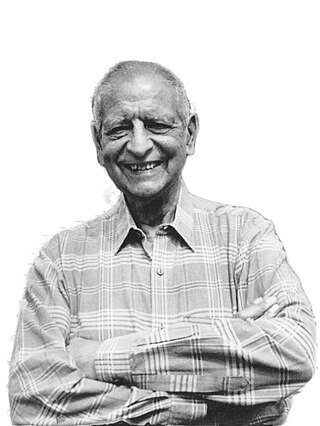
Kekoo Gandhy was an Indian art gallerist, art collector and art connoisseur, who pioneered the promotion of Indian modern art from the 1940s. He established Chemould Frames, a frame manufacturing business in 1941, soon he started displaying works of young modern artists K. H. Ara, S. H. Raza, K. K. Hebbar and M. F. Husain in his showroom windows. This led to gradual rise of modern art movement and post-colonial art in India. Eventually Gallery Chemould, India's first commercial art gallery, was opened in 1963 on the first floor of the Jehangir Art Gallery.

Amdavad ni Gufa is an underground art gallery in Ahmedabad, India. Designed by the architect Balkrishna Vithaldas Doshi, it exhibits works of the Indian artist Maqbool Fida Husain. The gallery represents a unique juxtaposition of architecture and art. The cave-like underground structure has a roof made of multiple interconnected domes, covered with a mosaic of tiles. On the inside, irregular tree-like columns support the domes. It was earlier known as Husain-Doshi ni Gufa.
Manubhai Pancholi also known by his pen name Darshak, was a Gujarati language novelist, author, educationist and politician from Gujarat, India. He participated in the Indian independence movement and held several offices after independence.
Somalal Shah was an Indian painter and art teacher. Born in Kapadvanj and educated in Bombay and Calcutta, he spent three decades painting and teaching art in Bhavnagar in Saurashtra, Gujarat.

Bey Yaar is a 2014 Indian Gujarati-language coming-of-age film directed by Abhishek Jain. The film is about friendship and focuses on two childhood friends. The film stars Manoj Joshi, Darshan Jariwala, Divyang Thakkar, Pratik Gandhi, Amit Mistry, Samvedna Suwalka. The film was released on 29 August 2014. It received positive reviews and became a box-office success. It completed 50 weeks in theatres. The film was screened at the New York Indian Film Festival, becoming the first ever Gujarati film hosted by the festival.
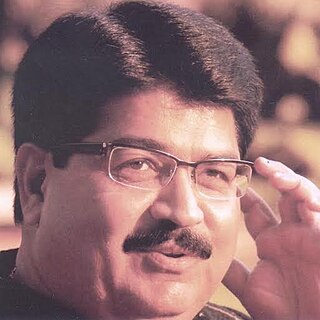
Parimal Dhirajlal Nathwani is an Indian politician and industrialist. He is a M.P, Rajya Sabha from Andhra Pradesh since the 2020 Rajya Sabha elections, previously serving as a Rajya Sabha MP for Jharkhand from 2008-2020.

Abhinay Banker is an actor, director, and writer who works in Gujarati cinema and theatre. After several theatre performances in his early career, he received recognition for his performance in Gujarati play Welcome Zindagi (2010), written and directed by Saumya Joshi, which has been performed over 650 times worldwide. He acted in Gujarati film Kevi Rite Jaish (2012).

Kumar is a Gujarati literary magazine founded by Gujarati artist and author Ravishankar Raval in 1924. It is now edited by Dhiru Parikh. The headquarters is in Ahmedabad, Gujarat, India.
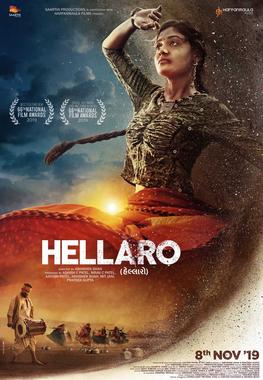
Hellaro is a 2019 Indian Gujarati period drama film co-written and directed by Abhishek Shah and produced by Ashish Patel, Nirav Patel, Aayush Patel, Prateek Gupta, Mit Jani and Abhishek Shah under the banner of Saarthi Productions and Harfanmaula films. The film having ensemble cast of Jayesh More, Shraddha Dangar, Brinda Trivedi Nayak, Shachi Joshi, Niilam Paanchal, Tejal Panchasara and Kausambi Bhatt, marks the directorial debut of Abhishek Shah. The film revolves around a group of women living in the Rann of Kutch in the 1970s.

Yazdi Naoshriwan Karanjia is a Gujarati theatre person from India. He is based in Surat and widely noted as one of the doyens of Parsi theatre.
Uttamlal Keshavlal Trivedi was a Gujarati writer and translator from India.
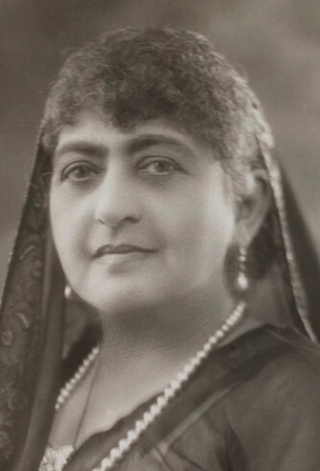
Dhunbai Cowasji Jehangir was an Indian philanthropist and leader of women's organizations, based in Bombay.
Samuel Fyzee-Rahamin was an Indian painter and artist who is known as one of the founders of modern Indian painting. One of the first Indians to study at the Royal Academy of Arts in London, he rejected his western academic training to paint in a distinctly Indian style, inspired by traditional Rajasthani paintings and Mughal miniatures. He married Atiya Begum, a pioneering Muslim intellectual and feminist with whom he also collaborated creatively. Globally acclaimed by the 1920s, his most significant work was the frescoes he did on the Imperial Secretariat in New Delhi towards the end of the 1920s. Following the Partition of India, he emigrated to Pakistan with his wife where he died in poverty in Karachi in 1964.














